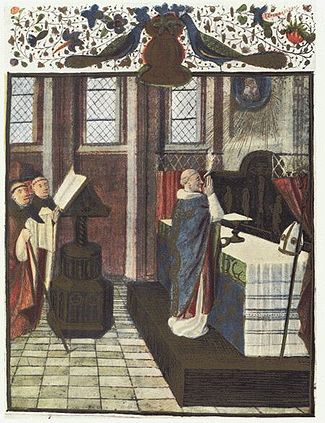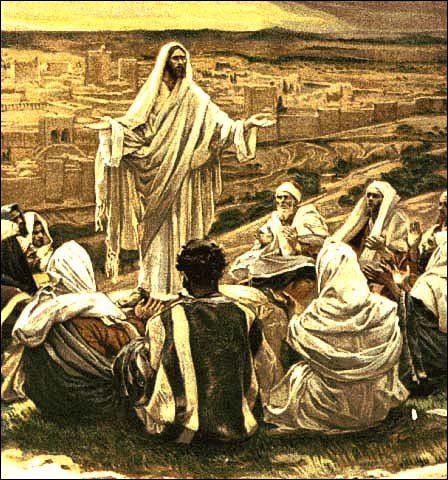The following text is the Ordo Missae of the aforementioned Missal (

THE ORDO MISSAE, TAKEN FROM THE 1474 MISSALE ROMANUM MEDIOLANI, Editio Princeps
Paratus Sacerdos cum intrat ad Altare dicat.
V./ Introibo ad Altare Dei.
R./ Ad Deum qui letificat iuuentutem meam.
Ps. Iudica me, Deus totum deinde repetitur versus Introibo ad Altare Dei.
R./ Ad Deum qui letificat iuuentutem meam.
Deinde facit Confessionem et Absolutionem et hinc dicit uersus.
V. Deus tu conversus uiuificabis nos.
R. Et plebs tua letabitur in te.
R. Ostende nobis Domine misericordiam tuam.
R. Et salutare tuum da nobis.
R. Domine exaudi orationem meam.
R. Et clamor meus ad te ueniat.
R. Dominus uobiscum.
R. Et cum spiritu tuo.
Aufer a nobis quesumus Domine iniquitates nostras ut ad Sancta Sanctorum puris mereamur mentibus introire. Per Xpm Dominum nostrum. Amen.
Postea inclinatus dicit secreto hanc orationem: Oramus te Domine per merita sanctorum tuorum quorum reliquie hic sunt, et omnium Sanctorum ut indulgere digneris omnia peccata mea. Amen.
Qua completa ascendit ad Altare et deosculans illud accipiensque turribulum a Diacono legit Introitum cum ministris deinde dicit an dicendum est:
Gloria in excelsis Deo et in terra pax hominibus bone voluntatis. Laudamus te. Benedicimus te. Adoramus te. Glorificamus te. Gratias agimus tibi propter magnam gloriam tuam. Domine Deus Rex celestis Deus Pater omnipotens. Domine Fili unigenite Iesu Xpe. Domine Deus Agnus Dei Filius Patris. Qui tollis peccata mundi miserere nobis. Qui tollis peccata mundi suscipe deprecationem nostram. Qui sedes ad dexteram Patris miserere nobis. Quoniam tu solus Sanctus. Tu solus Dominus. Tu solus Altissimus, Iesu Xpe. Cum Sancto Spiritu in gloria Dei Patris. Amen.
Quo finito antequam dicat Dominus uobiscum osculatur Altare in medio.
In fine Gradualis uel Alleluia uel Tractus inclinat se. Diaconus coram Altari et dicit hanc orationem:
Munda cor meum ac labia mea omnipotens Deus qui labia Ysaie prophete calculo mundasti ignito ita me tua grata miseratione dignare mundare ut sanctum Euangelium tuum digne ualeam nuntiare. Per Xpm Dominum nostrum. Amen.
Dicta oratione et accepto testu inclinat se Sacerdoti celebraturo et petit benedictionem dicendo: Iube domne benedicere. Tunc dicit Sacerdos: Dominus sit in corde tuo et in labiis tuis ut digne et competenter annunties Euangelium suum in nomine Patris et Filii et Spiritus Sancti. Amen.
===================================
The Priest prepares to go to the Altar and says:
V./ I will go to the Altar of God.
R./ To God, the joy of my youth.
V./ Judge me, O God...(the whole Psalm is recited; then is repeated the verse:) I will go to the Altar of God.
R./ To God, the joy of my youth.
Afterwards the Confession and Absolution is made; then the following verse is said:
V. Turn to us, O God, and bring us life.
R. And Your people will rejoice in You.
V. Show us, Lord, Your mercy.
R. And grant us Your salvation.
V. O Lord, hear my prayer.
R. And let my cry come to You.
V. May the Lord be with you.
R. And with your spirit.
Take away from us, O Lord, we beseech You, our sins, that we may enter with pure minds into the Holy of Holies; through Christ our Lord. Amen.
Afterwards he shall bow and say the following prayer in secret: We beseech You, O Lord, by the merits of Your Saints, whose relics lie here, and of all the Saints, deign in your mercy to pardon me all my sins. Amen.
Completing these things, the Priest shall ascend to the Altar and kiss it, take the thurible from the Deacon, and with the ministers recite the Introit. Then he shall say or intone the following:
Glory to God in the highest, and on Earth peace to men of good will.
We praise You, We bless You, We adore You, We glorify You;
We give You thanks for Your great glory.
Lord God, heavenly King, God the Father Almighty.
Lord, the only-begotten Son Jesus Christ; Lord God, Lamb of God, Son of the Father.
You who take away the sins of the world, have mercy upon us.
You who take away the sins of the world, receive our prayer.
You who are seated at the right of the Father, have mercy upon us.
For You alone are Holy; You alone are the Lord.
You alone are the Most High, Jesus Christ, with the Holy Spirit, in the glory of God the Father. Amen.
When it is finished, he shall say The Lord be with you before kissing the Altar in the middle.
He shall then bow at the end of the Gradual, or the Alleluia, or the Tract. The Deacon shall come before the Altar and say the following prayer:
Cleanse my heart and my lips, O Almighty God, who cleansed the lips of the Prophet Isaiah with a burning coal. Through Your gracious mercy deign so to purify me that I may worthily proclaim Your holy Gospel; through Christ our Lord. Amen.
After saying the prayer and taking the Text, he shall bow before the celebrant Priest and ask for a blessing, saying: Grant, sir, to bless. Then the Priest shall say:May the Lord be in your heart and on your lips that your may worthily and fittingly proclaim His Gospel; in the name of the Father, and of the Son and of the Holy Spirit. Amen.
Paratus Sacerdos cum intrat ad Altare dicat.
V./ Introibo ad Altare Dei.
R./ Ad Deum qui letificat iuuentutem meam.
Ps. Iudica me, Deus totum deinde repetitur versus Introibo ad Altare Dei.
R./ Ad Deum qui letificat iuuentutem meam.
Deinde facit Confessionem et Absolutionem et hinc dicit uersus.
V. Deus tu conversus uiuificabis nos.
R. Et plebs tua letabitur in te.
R. Ostende nobis Domine misericordiam tuam.
R. Et salutare tuum da nobis.
R. Domine exaudi orationem meam.
R. Et clamor meus ad te ueniat.
R. Dominus uobiscum.
R. Et cum spiritu tuo.
Aufer a nobis quesumus Domine iniquitates nostras ut ad Sancta Sanctorum puris mereamur mentibus introire. Per Xpm Dominum nostrum. Amen.
Postea inclinatus dicit secreto hanc orationem: Oramus te Domine per merita sanctorum tuorum quorum reliquie hic sunt, et omnium Sanctorum ut indulgere digneris omnia peccata mea. Amen.
Qua completa ascendit ad Altare et deosculans illud accipiensque turribulum a Diacono legit Introitum cum ministris deinde dicit an dicendum est:
Gloria in excelsis Deo et in terra pax hominibus bone voluntatis. Laudamus te. Benedicimus te. Adoramus te. Glorificamus te. Gratias agimus tibi propter magnam gloriam tuam. Domine Deus Rex celestis Deus Pater omnipotens. Domine Fili unigenite Iesu Xpe. Domine Deus Agnus Dei Filius Patris. Qui tollis peccata mundi miserere nobis. Qui tollis peccata mundi suscipe deprecationem nostram. Qui sedes ad dexteram Patris miserere nobis. Quoniam tu solus Sanctus. Tu solus Dominus. Tu solus Altissimus, Iesu Xpe. Cum Sancto Spiritu in gloria Dei Patris. Amen.
Quo finito antequam dicat Dominus uobiscum osculatur Altare in medio.
In fine Gradualis uel Alleluia uel Tractus inclinat se. Diaconus coram Altari et dicit hanc orationem:
Munda cor meum ac labia mea omnipotens Deus qui labia Ysaie prophete calculo mundasti ignito ita me tua grata miseratione dignare mundare ut sanctum Euangelium tuum digne ualeam nuntiare. Per Xpm Dominum nostrum. Amen.
Dicta oratione et accepto testu inclinat se Sacerdoti celebraturo et petit benedictionem dicendo: Iube domne benedicere. Tunc dicit Sacerdos: Dominus sit in corde tuo et in labiis tuis ut digne et competenter annunties Euangelium suum in nomine Patris et Filii et Spiritus Sancti. Amen.
===================================
The Priest prepares to go to the Altar and says:
V./ I will go to the Altar of God.
R./ To God, the joy of my youth.
V./ Judge me, O God...(the whole Psalm is recited; then is repeated the verse:) I will go to the Altar of God.
R./ To God, the joy of my youth.
Afterwards the Confession and Absolution is made; then the following verse is said:
V. Turn to us, O God, and bring us life.
R. And Your people will rejoice in You.
V. Show us, Lord, Your mercy.
R. And grant us Your salvation.
V. O Lord, hear my prayer.
R. And let my cry come to You.
V. May the Lord be with you.
R. And with your spirit.
Take away from us, O Lord, we beseech You, our sins, that we may enter with pure minds into the Holy of Holies; through Christ our Lord. Amen.
Afterwards he shall bow and say the following prayer in secret: We beseech You, O Lord, by the merits of Your Saints, whose relics lie here, and of all the Saints, deign in your mercy to pardon me all my sins. Amen.
Completing these things, the Priest shall ascend to the Altar and kiss it, take the thurible from the Deacon, and with the ministers recite the Introit. Then he shall say or intone the following:
Glory to God in the highest, and on Earth peace to men of good will.
We praise You, We bless You, We adore You, We glorify You;
We give You thanks for Your great glory.
Lord God, heavenly King, God the Father Almighty.
Lord, the only-begotten Son Jesus Christ; Lord God, Lamb of God, Son of the Father.
You who take away the sins of the world, have mercy upon us.
You who take away the sins of the world, receive our prayer.
You who are seated at the right of the Father, have mercy upon us.
For You alone are Holy; You alone are the Lord.
You alone are the Most High, Jesus Christ, with the Holy Spirit, in the glory of God the Father. Amen.
When it is finished, he shall say The Lord be with you before kissing the Altar in the middle.
He shall then bow at the end of the Gradual, or the Alleluia, or the Tract. The Deacon shall come before the Altar and say the following prayer:
Cleanse my heart and my lips, O Almighty God, who cleansed the lips of the Prophet Isaiah with a burning coal. Through Your gracious mercy deign so to purify me that I may worthily proclaim Your holy Gospel; through Christ our Lord. Amen.
After saying the prayer and taking the Text, he shall bow before the celebrant Priest and ask for a blessing, saying: Grant, sir, to bless. Then the Priest shall say:May the Lord be in your heart and on your lips that your may worthily and fittingly proclaim His Gospel; in the name of the Father, and of the Son and of the Holy Spirit. Amen.



